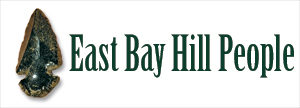excerpts from: Mount Diablo as Myth and Reality
Bev Ortiz – American Indian Quarterly – 1989
Located in present-day Contra Costa County, California, 3,849- foot Mount Diablo stands virtually alone,
The most prominent natural landmark for vast distances. Its expansive summit view reveals Mount Lassen to the north, Loma Prieta to the south and Yosemite to the east. Mount Diablo is featured in the tradition of several California Indian nations.

Mount Diablo was the focal point of the physical and symbolic world for many of the groups within its view, and they vividly reflect the connection of Indian people to the personages or supernatural beings who inhabited the world before this world and to reverse the popular image of Indian accounts as quaint stories rather than the underpinning of viable religious and social systems.
Among the Southern Maidu (Nisenan),Mount Diablo “was well known with religious significance”

Harrington’s Chochenyo (East Bay Ohlone) field notes convey an image of the mountain as a very powerful place which could mysteriously hide things, where large snakes were seen but could not be caught, and where spirits still danced and whistled at cemetery sites on its slopes.
Mount Diablo was the site of ceremonial activity. Pomo elder and doctor Mabel McKay (1985) related that in the Diablo area “medicine people would go up and hold ceremonies there.” According to Laime Hayem (1985), her people, the Wintun, also used the mountain for religious observances: Wintun religious leaders would go up Mount Diablo and pray. This was before the Spanish came and took the land from my people. They went up there to pray for good health, food, and the living to pray for what they wanted. They went there to talk to the spirits, their God, and to pray to the Heavenly Father. Mount Diablo is the Wintun’s sacred mountain.
Anthropologist Edward Gifford came to the mountain in the 1930s.There he was shown an area below the summit where Gifford related: “For generations, bands of Indians, men, women, and children made an annual trek to the summit of Mt. Diablo where they rendezvoused with other tribes of the region. The purpose was to participate in the intertribal autumn festival which lasted for a week or longer.”

Various central California Indian nations had many names for the mountain, but none was translated as an evil spirit or devil in their original sources. These names include the Northern Sierra Miwok “0j.ompil~e” (Merriam 1910; Callaghan 1986), Chochenyo “Tuyshtak” (Harrington 1929),Nisenan “Sukku jaman” (Uldall and Shipley 1966), and Central Sierra Miwok “Supemenenu” (Gifford 1955).
As early as 1811, Ramon Abella identified the mountain as “Cerro Alto de 1os Bolbones” or High Point of the Volvon.

An 1805 military expedition from San Francisco under the command of Gabriel Moraga became involved in “a hot engagement” with Indians at the foot of Mount Diablo. The Spanish were routed when “an unknown personage, decorated with the most extraordinary plumage” appeared. Following the Indians’ victory, this “Puy,” or “evil spirit,” departed for Mount Diablo.
This agent of the devil, which appeared in such extraordinary plumage was likely a kuksuyu, or sacred dance spirit representing the deity Kuksu and, as such, a powerful and important part of the religious observances of Central California Indian people . The feathered regalia worn by the dancer symbolized the relationship of the people to the supernatural.
Chochenyo consultants, described the “kuksui” dancer as wearing a headdress of the tip wingfeathers of the auron (golden eagle).

Over the years, there were occasional attempts to alter the mountain’s image. In 1866 the Congregational Church led an effort to change Mount Diablo’s name. On January 11 of that year, the San Francisco- based church newspaper published a front page editorial on the subject declaring, “We abhor the wicked creature to whom the name is inappropriate, and spurn the use of the name for anything noble or good on earth.” Church representatives suggested the name Kahwookum, a word learned from an unidentified Indian living at the base of the mountain. Despite the fact that church members could not communicate clearly with their consultant, they presumed that Kahwookum meant “Everywhere Seen” or “very nearly Pilot Mountain”: “We rejoiced at finding this diamond of a name for this splendid mountain.We wanted-a name with no devil in it – euphonious, original, becoming”.
Such examples demonstrate how the mountain’s Indian history has been ignored, devalued, belittled, and convoluted by non-Indian myths and legends.
Listen as Jim Cooper, an herb doctor who was born in the Diablo area told how sacred Mount Diablo is. He said that as long as the mountain stands it will be a sacred mountain. He said that the entire mountain is sacred. He called it the Medicine Mountain. In his language it was called Kinchiiwi.
Read Bev Ortiz’s entire article:
http://links.jstor.org/sici?sici=0095-182X%28198923%2913%3A4%3C457%3AMDAMAR%3E2.0.CO%3B2-O

